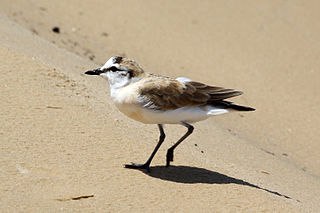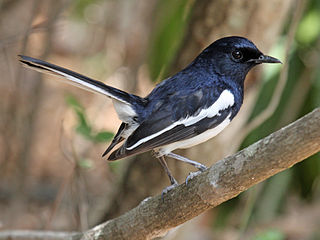
The family Vangidae comprises a group of often shrike-like medium-sized birds distributed from Asia to Africa, including the vangas of Madagascar to which the family owes its name. Many species in this family were previously classified elsewhere in other families. Recent molecular techniques made it possible to assign these species to Vangidae, thereby solving several taxonomic enigmas. The family contains 40 species divided into 21 genera.

The bushshrikes are smallish passerine birds. They were formerly classed with the true shrikes in the family Laniidae, but are now considered sufficiently distinctive to be separated from that group as the family Malaconotidae, a name that alludes to their fluffy back and rump feathers.

Corcoracidae is a family of passerine birds known as the Australian mudnesters. The family has sometimes been called Struthideidae in the past; however, despite Struthideidae being an older name than Corcoracidae, the latter name takes precedence. It contains just two species in two genera, the white-winged chough and the apostlebird. Both are endemic to Australia.

Kittlitz's plover is a small shorebird in the family Charadriidae that breeds near coastal and inland saltmarshes, sandy or muddy riverbanks or alkaline grasslands with short vegetation. It is native to much of Sub-Saharan Africa, the Nile Delta and Madagascar. It is thought to be mainly polygamous and has monomorphic plumage.

The helmet vanga is a distinctive-looking bird of the vanga family, Vangidae, and is classified in its own genus, Euryceros. It is mainly blue-black, with rufous wings and a huge arched blue bill. It is restricted to lowland and lower montane rainforests of northeastern Madagascar. Its diet is composed of invertebrates, predominantly insects. The species is threatened by habitat loss.

The white-fronted plover or white-fronted sandplover is a small shorebird of the family Charadriidae that inhabits sandy beaches, dunes, mudflats and the shores of rivers and lakes in sub-saharan Africa and Madagascar. It nests in small shallow scrapes in the ground and lays clutches of one to three eggs. The species is monogamous and long-lived, with a life expectancy of approximately 12 years. The vast majority of pairs that mate together stay together during the following years of breeding and retain the same territory. The white-fronted plover has a similar appearance to the Kentish plover, with a white fore crown and dark bands connecting the eyes to the bill.

The wattled starling is a nomadic resident bird in eastern and southern Africa. It is a species of grassland, open woodland, and cultivation.

The Madagascar plover, also known as the black-banded plover, is a small monogamous shorebird in the family Charadriidae, native to western Madagascar. It inhabits shores of lagoons, coastal grasslands, and breeds in salt marshes. These plovers mainly nest in open grassland and dry mudflats surrounding alkaline lakes. The species is classified as vulnerable by the IUCN because of its low breeding success, slow reproductive rate, and weak adaptation to increasing habitat loss, leading to declining population numbers.

The Madagascar hoopoe is a species of hoopoe in the family Upupidae. It was previously considered a subspecies of the hoopoe, but was split due to its vocalisations and small differences in plumage. Some taxonomists still consider all three species conspecific. Some authorities also keep the African and Eurasian hoopoe together, but split the Madagascar hoopoe. It is endemic to Madagascar, where its natural habitat is subtropical or tropical dry forest. It is a common bird and the International Union for Conservation of Nature considers its conservation status to be of least concern.

Margaret's batis or Boulton's batis, is a species of small passerine bird in the wattle-eyes family, Platysteiridae. It is found in south western central Africa.

The Senegal batis is a species of small passerine bird in the wattle-eyes family, Platysteiridae. It occurs in western Africa where it is found in dry savanna and subtropical or tropical dry shrubland. It was originally given the binomial name Muscicapa senegalensis by Carl Linnaeus in 1766.

The Madagascar magpie-robin is a species of chat in the Old World flycatcher family, Muscicapidae.

The Madagascar blue vanga is a bird species in the family Vangidae. It is found in Madagascar, where its natural habitats are subtropical or tropical dry forest and subtropical or tropical moist lowland forest.

The chabert vanga, also erroneously called "Chabert's vanga", is a species of bird in the family Vangidae. It is monotypic within the genus Leptopterus. The chabert vanga is the smallest bird in the vanga family when compared to the white-headed vanga and the blue vanga. Their biometrics are typically 14 centimeters in length and their weight ranges from 17 to 26.5 grams.

Crossley's vanga, also known as Crossley's babbler-vanga, Crossley's babbler, Madagascar groundhunter, or Madagascar groundjumper, is a bird species in the family Vangidae.

The Malagasy paradise flycatcher is a species of bird in the family Monarchidae. It is found in Comoros, Madagascar, and Mayotte. Its natural habitats are subtropical or tropical dry forest and subtropical or tropical moist lowland forest.

Van Dam's vanga is a species of bird in the family Vangidae. It is endemic to Madagascar.

Lafresnaye's vanga is a species of bird in the vanga family Vangidae. The species is monotypic and one of three species in the genus Xenopirostris. It is endemic to the south and south west of Madagascar. It inhabits sub-arid thorn scrub, in the Madagascar spiny forests ecoregion, particularly areas with large amounts of dead wood, from sea level to 100 m (330 ft). The species has a small range is not common within that range. It was uplisted from Least Concern to Near Threatened in 2022 as it is experiencing moderately rapid population decline owing to habitat degradation and loss within its range.
The rufous-bellied helmetshrike or Gabon helmetshrike is a passerine bird belonging to the Vanga family, Vangidae. It inhabits tropical forest in Central Africa. It is sometimes included within the chestnut-bellied helmetshrike of West Africa.




















